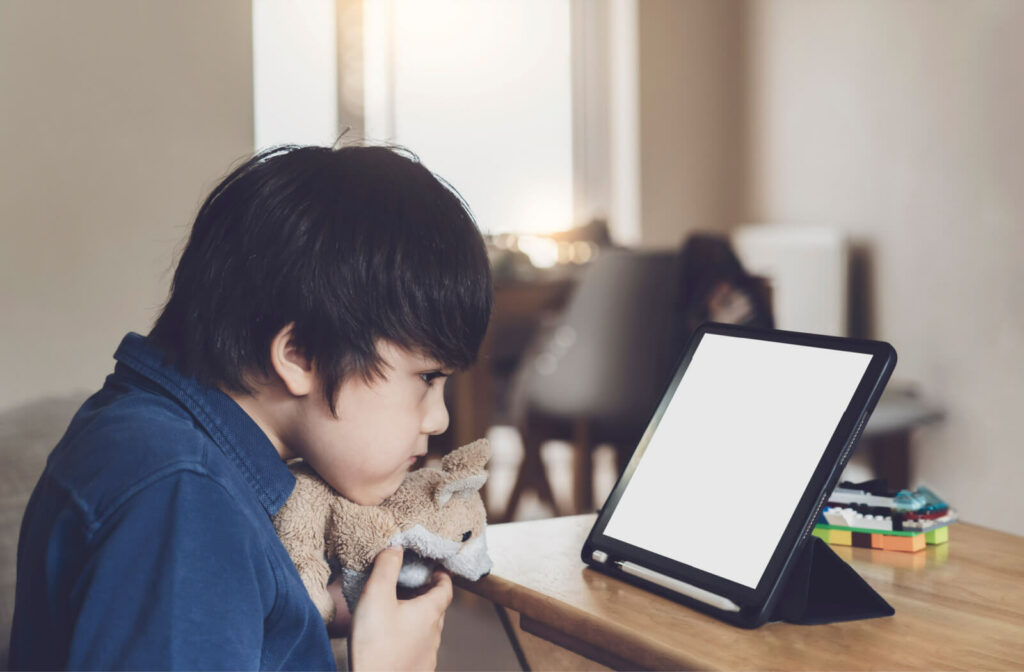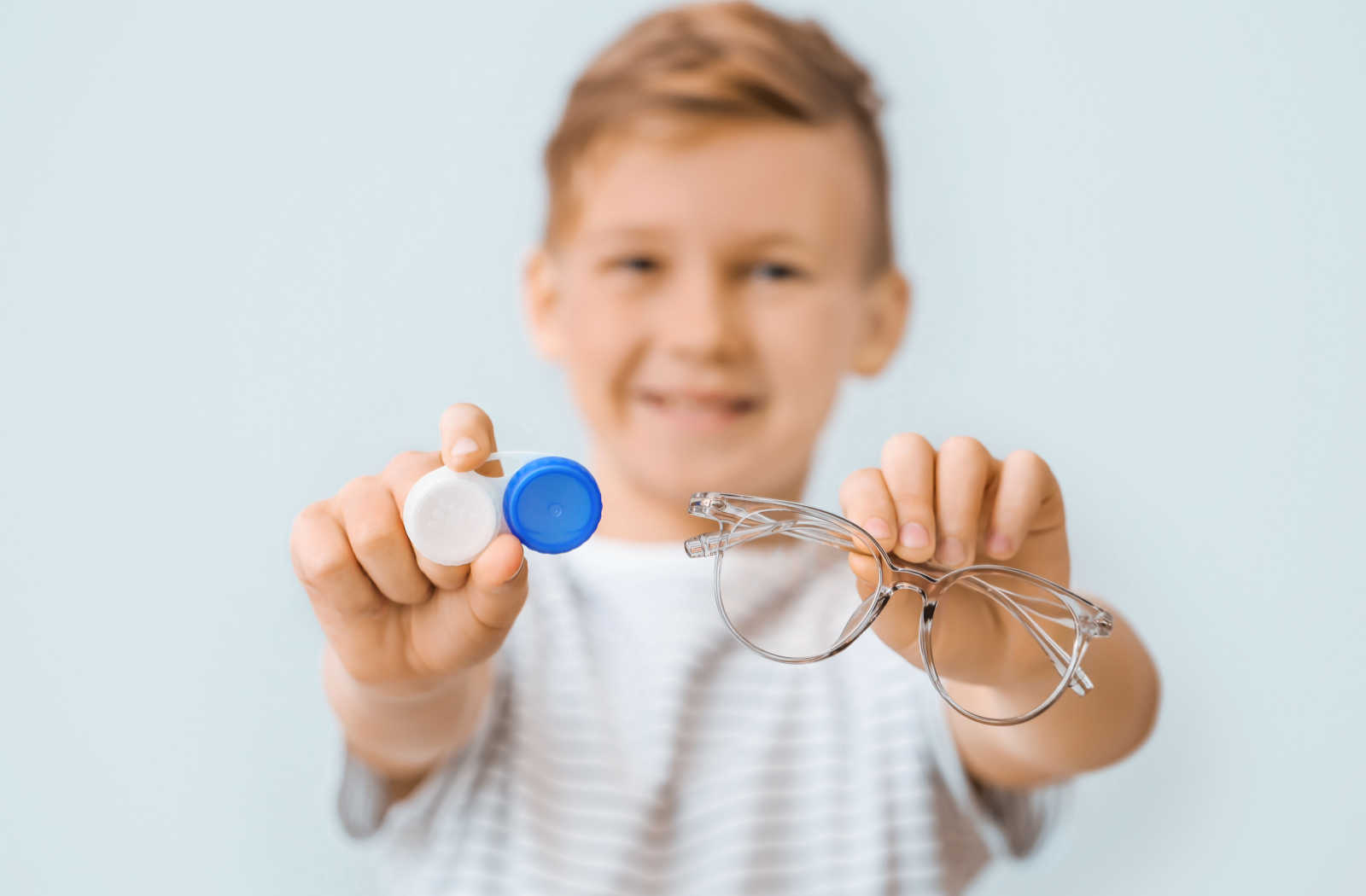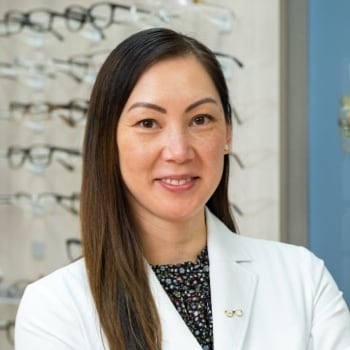Nearsightedness, also known as myopia, is one of the most common childhood refractive errors. It affects around 40% of Americans, with some projections saying as much as 50% of the world will have it by 2050.
Nearsightedness usually first appears in childhood and is often diagnosed in a comprehensive eye exam. It means your child can see objects clearly close up while objects far away are blurry. Because it’s so common, it’s one of the main things your optometrist looks for in early examinations. If discovered, you can be confident that many effective myopia control treatments exist today, including corrective lenses, specially designed contact lenses, and medical drops.
What Is Nearsightedness?
Proper eyesight begins when light enters your eye through the cornea, the clear dome at the front of your eye. It takes those rays and bends them into the crystalline lens behind your iris. The lens further bends the light to focus on the back of the eye, to a collection of cells called the retina. You get a clear image only when all these parts work together.
This process of bending light is also called refraction, which is why it’s called a refractive error when vision becomes blurry. In the case of nearsightedness, the eye has grown too long, becoming more of an oval than a sphere, or the cornea has become too steep. As a result, light rays coming through the cornea and lens don’t focus on the retina and, instead, focus just in front of it.
The reason why this happens may be genetic. Children of adults who are nearsighted may have a higher risk of developing it themselves. In addition, there is evidence that spending too much time doing close-up activities, increased screen time, or not going outside enough can result in nearsightedness.

Nearsightedness in Children
For most people, nearsightedness stops progressing around the age of 20. Before then, it can steadily get worse as your child’s eyes continue to grow. This progression is why it’s essential to have regular eye exams—the sooner nearsightedness is diagnosed, the sooner its progress can be slowed in a treatment called myopia control or myopia management.
It can be hard to tell if your child has vision problems—it’s the only vision they’ve ever known. Watch for these signs and symptoms and talk with your child to understand what they’re seeing:
- Headaches
- Eyestrain
- Eye rubbing
- Persistent squinting
- Excessive blinking
- Lack of awareness of distant objects
- Inability to see objects in the distance
- Trouble focusing in school
Cases of severe myopia have also been linked to serious eye conditions such as glaucoma, cataracts, and retinal detachment. For these reasons, it’s important to identify the best method for you and your child to halt or slow the progression of nearsightedness.
Eyeglasses & Contact Lenses
Glasses and contacts are the most common and simplest ways to correct nearsightedness. Whether your child wears corrective glasses or contact lenses, both can help correctly refract light toward the back of the eye.
However, single-power lenses won’t stop myopia from progressing. Some studies have shown that multifocal lenses have slowed the progression of myopia by up to 50%. These lenses have different prescriptions for near and far vision, the top for seeing faraway objects and the bottom for close-up work.
Multifocal contact lenses for myopia may appear similar to a bullseye. While the center corrects for nearsightedness, the outer portion adds focusing power that can help slow your child’s eye growth.
Ortho-K
Orthokeratology, also known as ortho-k, involves your child wearing special rigid gas-permeable contact lenses overnight while sleeping. The lenses gently reshape the cornea to improve the bending of light in the eye throughout the day.
The benefits of ortho-k include seeing clearly during the day and not worrying about losing or damaging glasses or contacts. However, ortho-k requires commitment, and your child must wear the lenses every night to maintain the desired level of vision. Studies have shown it to be a safe and effective means of slowing myopia progression.
Atropine Drops
You may have experienced atropine in one of your eye exams, as it’s commonly used to dilate your eyes so your doctor can inspect your retina. For children, a lower concentration of atropine eye drops may help in myopia control.
The best treatment for nearsightedness depends on your child’s lifestyle, preferences, and the severity of their condition. Your optometrist can discuss these options with you and your child to determine which is best for your unique circumstances.
Surgical Treatments for Nearsightedness
Currently, there is no way to reverse nearsightedness. Adults looking for long-term solutions might turn to laser eye surgery. There are several different types of laser eye surgery, and the one you may be recommended depends on your preferences or health factors. But, all types use a laser to reshape the cornea to correct nearsightedness. These types of surgery include:
These procedures are quick and can improve vision within a few hours or days of the operation.
Another type of laser surgery offered is an implantable collamer lens (ICL), in which an artificial lens is placed in the eye to help refract light.
However, laser eye surgery is not suitable for everyone, and it is vital to consult an eye care professional to determine if you are a good match for any of these procedures.
Understanding Myopia Control
Whether your child needs their nearsightedness managed or you’re looking for treatment for your own, the best thing you can do is learn more. Nearsightedness is a common condition that is only becoming more common, but vision experts continually develop innovative ways to help you manage it.
If you or your child are nearsighted and looking for a way to see clearly, book an appointment with our skilled team at Eyes on Plainville!





